Ants Vs. Termites

Ants Vs. Termites – Whats the difference?
Flying ants and swarming termites are often difficult to tell apart. Termites have relatively straight, beadlike antennae while ants have elbowed antennae. Termites have two pair of wings (front and back) that are of almost equal length. Ants also have two pair of wings but the fore wings are much larger than the hind wings. The abdomen of the termite is broadly joined to the thorax while the abdomen and thorax of the ant are joined by a narrow waist called a petiole.
The termite colony contains primary queens (long wings), secondary queens (short-winged and wingless), large headed soldier termites, and worker termites. Winged reproductives migrate (swarm) to initiate new colonies. The flight is short and weak with the wings often breaking off in flight. The outstanding difference between swarming termites and flying ants is the wide body of the termite as opposed to the constricted or pinched body of the ant. Termites can cause extensive damage in a relative short time.
The Pacific Dampwood Termite is the largest and may exceed 1 inch in length including the wings. They are cream-colored to reddish brown. The soldiers have a cream-colored body with a large reddish brown head and are approximately 3/4 inch long. The nymphs of the soldiers and reproductives are white to cream-colored and are about 1/2 inch in length. Wet or damp wood is necessary for attack and establishment of these termites. These termites live and nest in the wood which they feed and do not return to the soil like the subterranean termite. As colonies mature, they produce winged reproductives that leave the nest in swarming flights, which normally occur in the late summer or early fall. Being moisture dependent, and thus hiding themselves well to prevent moisture loss, termites are not easily observed.
The subterranean termite is much smaller than the dampwoods with the winged form being 3/8 inch long including the wings. They are dark brown to black with light gray wings. The soldiers have a cream-colored head with black mandibles and a grayish white body. They are approximately 1/4 inch long. The “worker” caste is grayish white and about 3/16 inch long. These termites live and nest in the soil which may originate near buried stumps, logs or other sources of wood as much as 10-20 feet deep. The subterraneans often enter structures through cold joints between slab and foundation walls, areas around plumbing, earth-filled slab porches and “tubing” up foundation walls where there is usually a wood source close to ground level. Termite tubing provides protection from natural enemies and more important, from dehydration. Subterranean termites may swarm at any time of year but is usually in the spring and fall, depending on weather conditions.
Control of the Dampwood termite is most often achieved by replacing structurally unsound wood, eliminating moisture sources and any wood-soil ground contact. Treatments for subterraneans are done to establish a chemical barrier between the sub-soil nest and the home. The application of most termiticides is limited to soil injection, sub-slab injection and trenching. Treatment areas most often cover along foundation walls, around pier supports beneath raised concrete porches that are adjacent to foundation walls, and on occasion patio or garage slabs. This process generally cannot be performed by the homeowner and requires the expertise of a licensed professional.
Click On The Pest Category To Learn More.
| Bedbug Guide | House Centipedes |
| Carpenter Ants | Mosquitoes |
| Clothes Moths | Roaches |
| Fly Facts | Ants vs Termites |
| Little Black Ant | Termites |
| Odorous House Ant | House Flies |
| Fruit Flies | Rodents |






